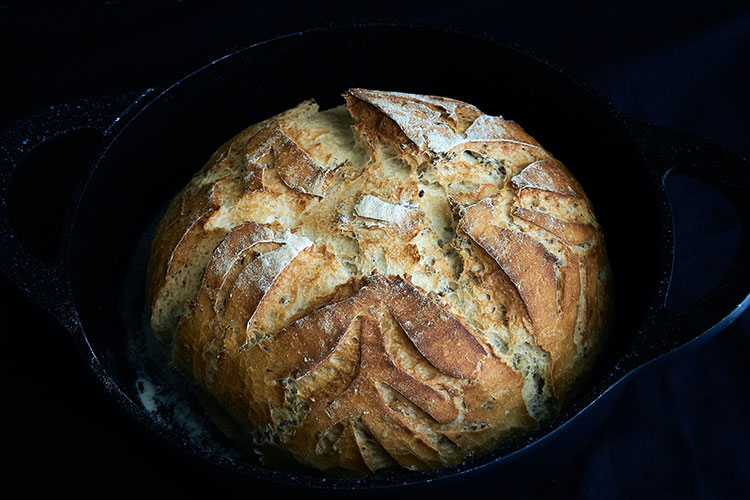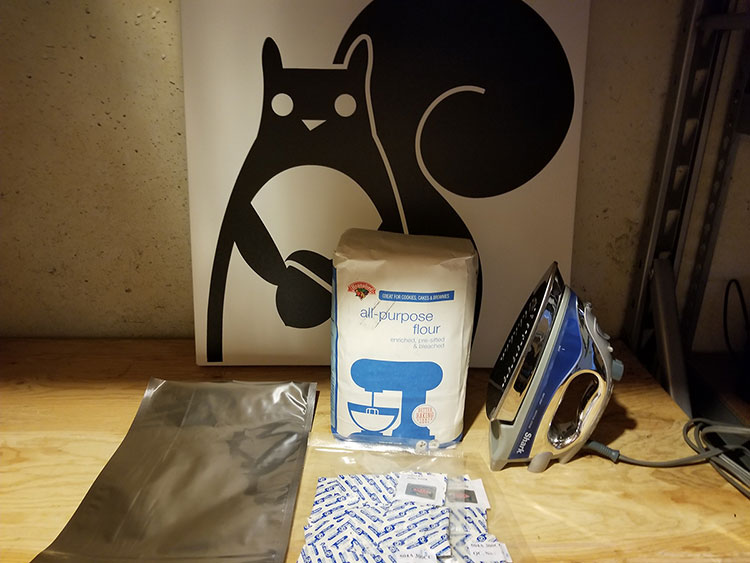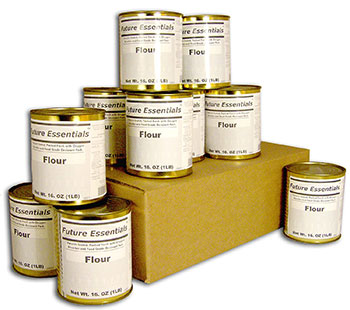
You’ve come to the realization that you need to up your food storage game. Storing common ingredients and making your own food from those is the most economical method. Do you know how to store flour long-term? That’s one of those basic ingredients essential to many foods.
Building a prepper pantry through buying bulk survival foods is convenient, but freeze dried pouches of space food and boxes of MREs is the least economical method. If you’ve been following this site for some time, you know that there are much cheaper and more readily available forms of food storage: flour being one of them. When combined with stored sugar, you have a few of the key ingredients needed for many different recipes.
Table of Contents
The Power of Flour
T.E. Lawrence (aka Lawrence of Arabia) wrote in his book The Seven Pillars of Wisdom about the importance of flour to his men. Logistically, flour allowed his troops fighting against the Turks during World War 1 to be able to take much longer trips into the desert.
You get more servings out of a pound of flour than you do a pound of rice. As a result, Lawrence’s men were able to hit the Turks unexpectedly from every conceivable angle. If they had solely carried rice, they wouldn’t have been able to load their camels with as much food, and so, flour played an important part in the winning of World War 1.
Flour is also a crucial ingredient in the prepper’s food storage because of how versatile it is. If you’re cooking from your food pantry, flour is critical. It is used in virtually all comfort foods, and comfort foods will go a long way toward combating appetite fatigue that can come when eating only from your food storage.
Historical Ways of Storing Flour
History often provides the best knowledge on storing foods for a long time because so many foods were stored long before modern technology and – mainly – refrigeration. Years ago farmers would have to thresh the wheat. Wheat heads were spread out on bare ground or floor. Cattle or horses walked over it until the what was removed from the chaff. Then came the modern threshing machine and its widespread use through the 19th and early 20th centuries.
Then the wheat was transported to the mill. According to Flour.com:
Since prehistoric times, the goal of milling has been the separation of outer bran and germ from the inner, more digestible, endosperm of the wheat berry. While primitive man probably simply chewed wheat as food, and later learned to parch it for easier eating, archeological excavations of even the earliest known villages indicate forms of grinding.
https://flour.com/flour/
However, flour had a very short shelf-life a hundred years ago, because producers had not yet figured out how to easily separate the germ from the rest of the seed. People would sift their flour to make “white” flour, but the flour still contained wheat germ. It wasn’t until the late 1800s when milling flour with steel rollers became commonplace and enable the production of fine white flour. With the wheat germ oil now gone, the flour became more shelf-stable.
How Long Can You Store Flour?
The length of time that your flour will be good for depends on a number of variables, including how you store it. If you leave it at room temperature, refined flour will be good for up to a year when well-stored in a pantry. In the fridge it should be good for at least a year. If you keep your flour in the freezer, you should be good for two years. This is for white flour.
| Airtight Container | Fridge | Freezer | Mylar Bags and O2 Absorbers | |
|---|---|---|---|---|
| Refined White Flour | 1 year | 1 years | 2 years | 10+ years |
| Whole Wheat Flour | 3-6 months | 6-8 months | 2 years | 5+ years |
Personally, I’m rather of the opinion that stuff kept in the freezer should last indefinitely – I mean, it’s too cold for anything to rot in there – but the “official” time is that flour lasts two years frozen.
If it’s a whole wheat flour that you’re storing, then those numbers go down rather significantly. Whole wheat flour should last somewhere between 3-6 months at room temperature, 6-8 months in the fridge, and once again, 2 years if stuck in a freezer that stays at 0 degrees Fahrenheit (source).
Preppers store flour using Mylar bags and oxygen absorbers, often with food grade buckets. More on that in a bit.
Keep in mind that the shelf life of any flour other than refined white flour is most likely going to be exponentially shorter. Gluten-free alternatives, such as almond or coconut flour, contain so many oils that they are naturally going to go rancid quicker, as do buckwheat, rye, amaranth, and oat flour.
White flour will store the longest. You sacrifice some nutrition with white flour, but if long-term storage is your primary goal, it’s worth it.
- NO COLOR ADDED: Gold Medal Unbleached Flour has no added color for baking breads and cakes
- UNBLEACHED FLOUR: Ready-to-use flour that can be used for any recipe that simply calls for flour
You’ll know if your flour is rancid or not by the smell. If you open up your flour stores to find that there’s a musty, oily, sour smell – throw it out!
Using a Freezer
If you do decide to freeze your flour to keep it longer, then let it sit out until it reaches room temperature before you use it. This will help to prevent the flour from lumping, and you’ll have a much more pleasant cooking/eating experience as a result.
Why Flour Goes Bad
Understanding the enemies of flour is the first step in protecting it for long-term storage. Flour can go bad because of bugs, moisture, and oxidation.
Bugs
There’s a high probability that the flour you just bought from the store has either weevils or weevil eggs inside. Possibly both. That’s normally not a huge deal, as you probably finish off the entire bag before the bugs can cause too much damage/become too prolific.
However, if you plan on storing flour for the long term, you’re going to want to take every precaution that you can to protect your investment. Opening a bag of flour post-disaster/collapse only to discover that it is filled with little bugs is not a very appetizing or comforting thought.
Killing Bugs in Flour
There are two ways that we can combat bugs in flour. The first would be to stick your flour in the freezer for 48 hours as soon as you get home. This will kill any bugs and eggs that are already in your flour, so you’ll know that you’ll be starting off with a “clean” batch.

The second step would be to ensure that you are storing your flour in a bug-proof container. That little paper bag that your flour comes in is most certainly not that. If a bug wants in bad enough, it can most certainly find a way through paper. No, for the long haul, you need an impermeable food container that you can seal off in order to better ensure that your flour is safe from outside attackers.
What do you do if society crumbles into in an apocalypse and you find weevils in your flour? Eat it anyway.
Moisture
If you want your flour to last as long as possible, you have to keep it as dry as possible. The presence of moisture in your flour will exponentially speed up the decomposition process. So what can we do? Well, one of the first things that you need to do, is you need to get it out of that little paper sack that it comes in. Paper is incredibly moisture absorbent, and combined with the bug issue, it adds extra incentive to get your flour into an airtight container as soon as possible.
The next best thing that you can do to fight moisture is to store your flour in a dry and cool place. If you plop it down on the concrete floor in your damp basement, you’re going to have problems. Store it in a dry, dark pantry and you’ll be in a much better position.
Oxidation
Oxidation is the chemical reaction that occurs when a substance (in this case flour) comes in contact with oxygen. This is another reason why airtight containers are so important.
Place flour in an airtight container and spread some more over the kitchen counter and leave them. Which do you think will go bad first? Naturally, the flour that has been spread out because it’s exposed to more oxygen.
Oxygen causes the flour to break down faster. This goes for both white and wheat flour, but it’s very rapid with wheat flour. Oxidation is a reason so many preppers store flour long-term with the classic Mylar bag method.
Storing Flour with Mylar and Buckets
As far as what to store your flour in, I recommend 5-gallon food-grade buckets. You can buy these online or try your local bakery. Make sure you are using food-safe bucket so you’ll know that whatever you put into them won’t absorb any potentially harmful chemicals.
Shorter Term
You should be able to get anywhere between 30-35 pounds of flour in these buckets. Just make sure that you have gamma seal lids for them. You can easily pick these up online, and they’ll significantly improve the life of your flour, as they do a superior job in keeping moisture out of the bucket. The flour can be stored directly in the bucket itself or inside Ziplock bags in the bucket.
Longer Term
Those buckets are good for general storage and for long-term storage, but for the latter you want to take an additional step – Mylar bags and oxygen absorbers. This is the standard food storage method preferred by preppers and it’s also how we advise you to store coffee beans. The Mylar is constructed from metalized polyester, impenetrable to those pesky weevils while simultaneously sealing out all light.

All you need are the bags, a hot iron, and a stack of oxygen absorbers. With enough O2 absorbers, 99.99% of the oxygen will be removed.
Storing flour for the long term involves just a few steps:
- Pour your flour in the Mylar bag
- Toss in several oxygen absorbers
- Seal the end of the bag tight with a hot clothes iron
- Wait for the O2 absorbers to work (4-6 hours)
- Stack your sealed flour away for the apocalypse
For Mylar bags used to store flour, I would skip the larger bags and focus instead on sealing the flour in 1-gallon bags. They require more upfront time to seal and store, but if/when you need to access your flour, you will be thankful that you’re opening 1-gallon bags and not 5-gallon bags.
- ✅ [ Food Grade ] - Packet material is food safe and strictly tested for food purpose, safe to be used with foods.
- ✅ [ Light Proof ] - 4 Mil thick each side mylar with excellent light and oxidation protection, commonly used for long-term emergency food storage and daily dehydrated foods storage like grains, beans, oats, wheat, pasta, rice etc.
Storing flour in smaller Mylar bags will also create a level of insurance. If a 5-gallon bag is compromised, you lose a 5 times the flour you would if a 1-gallon bag was compromised. Still, this may be impractical for people with large families or groups of people looking to put away serious amounts of food. If that describes you, then go ahead and use 5-gallon Mylar bags.
Using Enough Oxygen Absorbers
| Container | Dense Food (wheat, flour, grains) | Less Dense Food (pasta, beans) |
|---|---|---|
| Food Storage Buckets | Total CCs | Total CCs |
| 6-Gallon Food Bucket | 2000 | 2500-3000 |
| 5-Gallon Food Bucket | 2000 | 2500-3000 |
| Mylar Food Storage Bags | Total CCs | Total CCs |
| 20″ x 30″ (4.25, 5, and 6 gal) | 2000 | 2500-3000 |
| 18″ x 28″ (4.25, 5, and 6 gal) | 2000 | 2500-3000 |
| 14″ x 20″ (2 gal) | 1000 | 1500-2000 |
| 14″ x 18″ x 6″ (2 gal) | 1000 | 1500-2000 |
| 12″ x 18″ (1.5 gal) | 500-800 | 1000-1200 |
| 12″ x 16″ x 6″ (1.5 gal) | 500-800 | 1000-1200 |
| 10″ x 14″ (1 gal) | 300-400 | 400 |
| 10″ x 14″ x 4″ (1 gal) | 300-400 | 400 |
| 8″ x 12″ (1/2 gal) | 100-200 | 200-400 |
| 8″ x 12″ x 4″ (1/2 gal) | 100-200 | 200-400 |
| 6″ x 10″ (1/4 gal) | 100 | 100-200 |
| 6″ x 8″ x 2″ (1/4 gal) | 100 | 100-200 |
Most long-term food storage suppliers don’t sell absorbers, probably because they don’t want you storing your own. They’d rather you just buy their products. Amazon, for better or worse, is the easiest spot to shop for these:
- 200CC (100-Pack) by O2frepak Store
- 300CC (100-Pack) by wisedry Store
- 500CC (50-Pack) by O2frepak Store
- 1000CC (30-Pack) by VacYaYa Store
- 2000CC (10-Pack) by FreshUS
I try to seal enough products in one setting so that all of the absorbers get used at once; i.e. I’m not leaving a half bag of absorbers. It’s fine if you do, just make sure you seal up the unused absorbers so they’re not absorbing oxygen.

Buying Canned All Purpose Flour
If you’ve got the money and want to make 100% sure that your flour will be good when you open it, there is the alternative of buying all purpose canned flour. A more expensive option akin to buying pre-freeze dried food, but an option nonetheless.
Grinding Wheat Instead
Want to take your flour storage to a whole new level? Save wheat instead, then – when needed – grind it into flour. There are several reasons to actually grind your own flour, should that be a route you want to explore. The most common flour eaten within the States is comprised of wheat berries (though there are a multitude of others). Buckwheat, rye, amaranth, and oats can all be used to create flour as well, but when most people refer to “flour”, they’re talking about wheat.

You can buy and store wheat yourself here. You can also grow it. Of course, you’ll need a grain mill, and if you’re prepping for a collapse, you’ll want one that doesn’t require electricity. Storing the grain is similar to storing the flour, it will just last even longer. When stored properly, expect stored grain to last 30 years or longer.
Pros and Cons of Grinding Your Own Wheat
Everything has its advantages and disadvantages, of course. Grinding your own wheat is no exception.
Pros:
- Wheat berries can be planted to grow more wheat. Not only does this provide you a form of renewable food, but it also has barter potential.
- Wheat berries have more nutrition in them than refined flour. This is because wheat berries contain all three components of a grain: the bran, the endosperm, and the germ. Refined wheat only contains the endosperm.
- Perchance you drop wheat berries, you just pick them back up and move on. If you spill flour, it’s toast.
Cons:
- Because wheat berries contain more oils than refined flour, they will go rancid if exposed to oxygen for too long.
- In my experience, wheat berries are harder to find than refined flour is.
- You’ll need a way to mill your wheat berries into flour before you can use them. Flour is good to go already.
- Wheat berries need to be stored with oxygen absorbers to minimize the amount that air will degrade the oils inherent to the berries. Not a huge con, I suppose, but just another step that you have to do.
- Flour mills (at least good ones) can be rather expensive.
Storing Flour Long-Term Summarized
You invest a lot of time, energy, and space into ensuring that your family is protected in the event of a disaster. If you don’t take the necessary steps to protect your investment, then you’re doing things half-baked (no pun intended). By following the above steps, you’ll be much better off to ensuring that your family will have the supplies that they need when you need them more than you ever did before.
Are there other tips and tricks that you’ve learned when it comes to storing flour? Have you had personal experience with any of these reasons for flour going bad? Let us know in the comments below!


![wisedry [100 Packs] 1-Gallon Mylar Bags (4 Mil, 15''x10'') with 300cc Oxygen Absorbers Packets for Dehydrated Vegetables, Grains, Legumes and Emergency Long Term Food Storage, Food Grade](https://m.media-amazon.com/images/I/41n89UROq5L._SL160_.jpg)
9 comments
That quote from Lawrence of Arabia is awesome.
Great article, well done!
I didn’t use mylar bags. I got containers with a seal that will be air tight and added oxygen absorbers. I think this will last pretty long
Would it be reasonable to put five pound bags of flour in the freezer for a couple of days, then leave the bag intact and store the full bags inside food grade buckets? Even with using food grade, I’d like to have the flour in as little contact with plastic as possible.
You can, but that does not eliminate oxygen.
Can you store biscuit flour mix long term. The product is southern biscuit complete mix
Packaged well, it can store long term, yes. “Long term” differs for everything, but you can certainly improve its storage life.
It sounds like, as with rice, I can freeze the flour for a few days to kill off bugs, then transfer it to a mason jar with a few O2 absorbers and place in a cool, dark place? I am planning to do this with coffee as well (although I don’t think I need to freeze first). Any thoughts? Thanks for a great site!
With white flour, store bought, is there a major concern with botulism when storing it with oxygen absorbers? I have several bags of white flour in the original bag packaging that has sat on my counter for a few months. The date on the bag is still good, but I do have high humidity in my kitchen. Is this flour still safe to eat now and is it safe to store using oxygen absorbers? Thank you!
I would think you’re good. Botulism would be a bigger concern with canning. I’d just use it up and/or freeze it. Buy some fresh flour to store long-term.